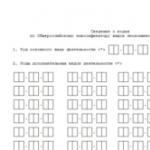29 servicing industries and farms. Expenses for service industries and farms. Reflection of production maintenance costs
If there are service industries and farms on the balance sheet of an organization, their costs are accounted for separately. The chart of accounts and the Instructions for its application are intended for these purposes to include active account 29 “Servicing industries and farms” ().
What applies to service industries and farms?
Service industries and farms are those productions and farms that are not related to the main activities of the organization for which the organization was created (production of products, performance of work or provision of services). For example, an industrial enterprise owns a dormitory for its employees, the company opens a canteen to provide meals for them, or has built a sanatorium for recreation and treatment of employees and other persons. The costs of such industries and enterprises are servicing (Order of the Ministry of Finance dated October 31, 2000 No. 94n).
Accounting on account 29
Expenses of service industries and farms are collected in the debit of account 29 and, depending on the type of costs, can be reflected as follows (Order of the Ministry of Finance dated October 31, 2000 No. 94n):
Debit of account 29 – Credit of accounts 02 “Depreciation of fixed assets”, 10 “Materials”, 23 “Auxiliary production”, 25 “General production expenses”, 60 “Settlements with suppliers and contractors”, 70 “Settlements with personnel for wages”, 69 “Calculations for social insurance and security”, etc.
Account 29 is credited for the amount of the actual cost of products completed, work performed or services rendered.
For example, the cost of capitalized materials or finished products manufactured by service industries and farms is reflected as follows:
Debit of accounts 10 “Materials”, 43 “Finished products” - Credit of account 29
If the work or services of service industries and farms were consumed within the organization itself, the postings may be as follows:
Debit accounts 25, 26 “General business expenses”, 44 “Sales expenses”, etc. – Credit account 29
When work or services performed by service industries and farms are sold externally, the cost of these works and services is written off as follows:
Debit account 90 “Sales” - Credit account 29
Accordingly, revenue is recognized for the cost of work performed or services provided:
Debit account 62 – Credit account 90
The debit balance of account 29 as of the reporting date shows the value of work in progress in service industries and farms. In the balance sheet, this value is reflected in line 1210 “Inventories” (
Why is count 29 needed?
Account 29 - Servicing production and facilities - reflects the expenses of the organization's divisions, whose activities are not related to the main purpose of creating the organization. These include, in particular:
- housing and communal services;
- household workshops;
- corporate canteens.
The purpose of service departments is to directly or indirectly support the operation of the main production. For example, if this is a canteen, then employees of the main departments can have lunch there.
The activities of service departments can be aimed at meeting the needs of:
- the service department itself (direct costs within this production are recorded here);
- other proceedings, primarily main (account 20), auxiliary (account 23);
- third party companies.
Let's consider which entries on account 29 correspond to each area of work of the service departments.
How is it applied and how is the account closed: postings
So, the service department can:
- Operate for yourself, incurring direct expenses. These may include:
- depreciation (its accrual is shown by posting Dt 29 Kt 02);
- employees, contributions (Dt 29 Kt 70, Dt 29 Kt 69);
- payment for third-party services, such as utilities (Dt 29 Kt 60).
- Operate to meet the needs of other departments.
As part of this function, the service department can:
Don't know your rights?
- purchase goods and materials for the manufacture of products at their facilities (Dt 29 Kt 10);
- pay wages to workers employed at such facilities (Dt 29 Kt 70, DtT 29 Kt 69);
- carry out depreciation of such capacities (Dt 29 Kt 02).
All expenses debited to account 29 are written off to the costs of the production that is supported:
- Dt 20 Kt 29 (if main production is supported);
- Dt 23 Kt 29 (if auxiliary production is supported).
- Operate by performing work to order from third-party companies.
In this case, the service department can:
- as in the case of activities for other departments, purchase materials, pay salaries to employees (the postings are similar), and then write off the costs incurred to general expenses (Dt 90.2 Kt 29);
- receive income from the provision of services on the side (after the conclusion of the contract, revenue is reflected: Dt 62 Kt 90.1, later funds are credited to the current account: Dt 51 Kt 62).
If account 90 is formed, it is recorded by posting Dt 90.9 Kt 99.
How analytical accounting is carried out on account 29: nuances
The account in question is synthetic, and various analytical accounts (or sub-accounts) can be opened within it for the purpose of detailing (additional identification) of business transactions. Analytical accounting for account 29 is carried out in accordance with:
- with industry standards;
- corporate standards.
If we talk about industry standards, the Ministry of Agriculture of Russia recommends using the following subaccounts (Order of the Ministry of Agriculture of Russia dated June 13, 2001 No. 654):
- 29.1 (for accounting for utility costs);
- 29.2 (used by agricultural enterprises to account for expenses aimed at ensuring productivity associated with caring for animals);
- 29.3 (household expenses);
- 29.4 (expenses within the activities of kindergartens on the balance sheet of the organization);
- 29.5 (activities of medical and preventive institutions);
- 29.6 (activities of cultural institutions);
- 29.7 (activity of catering facilities).
At the same time, the enterprise has the right to open any subaccounts to account 29. They must be fixed in the working chart of accounts, which is approved in the accounting policy.
An organization, in addition to its main production and those complementing it, may have various service capacities. Those expenses that are incurred on them may be related to the work of the service department for itself, to activities in the interests of other divisions of the company, or aimed at meeting the needs of third parties.
Account 29 is used by manufacturing enterprises that own their own service farms. Here information is collected on costs arising in the process of producing products or performing work (rendering services) that are necessary to carry out the main activity of the organization. For what purpose are service farms created and how they are accounted for, we learn from the article.
Concept and purpose
The production structure of any industrial enterprise is based on the interconnection of its divisions. This includes affiliates and subsidiaries, representative offices and branches, as well as individual product manufacturing lines. Among them are large industrial units (factories), as well as its constituent parts - departments (shops), sections, teams. The production structure may include a service facility. Its divisions do not participate in the creation of products for sale, but provide for the needs of main and auxiliary production.
The main task of the service economy is to ensure the continuous and optimal functioning of auxiliary and main production, by satisfying various industrial needs. If necessary, its workshops can take on part of the orders. This sometimes happens when equipment breaks down or when there is a need to make increased deliveries of products.
Composition of service production
This industrial division plays an important role in the production processes of products in the main activity of the enterprise. Service production is able to provide semi-finished products, materials and various services to all other departments. Typically this unit consists of:
- Transport workshop - provides services for the transportation of goods, equipment, materials and other material assets necessary for production. It is important that transportation is carried out only within the enterprise. According to its structure, it can be divided into sections (operational, dispatch, repair, etc.).
- Sales and supply services - provides the necessary materials and equipment, carries out work on the disposal of materials and other valuables that are not suitable for use. Carries out the sale of unclaimed inventories.
- Warehousing - stores and collects materials and equipment that may later be useful to the main or auxiliary production.
- Household premises and catering departments.

In addition, many large industrial enterprises have their own social and cultural complex, consisting of children's institutions (camps, kindergartens), cultural centers or recreation centers, and dormitories for employees. The costs of maintaining such premises, including utilities, are also reflected as part of the costs of service production.
Account 29
A large amount of information about the activities of the service business requires the allocation of a separate account for collecting data and recording it in accounting. Section III of the Standard Chart of Accounts contains account 29, which serves for such purposes. It has an active structure, since it is reflected in the assets of the balance sheet. In the process of carrying out business transactions, entries occur, which in debit mean an increase in direct expenses for the activities of service production, and in credit - their write-off and distribution among items.

This account, like other Section III accounts, accumulates expenses over a period. At the end of the month, amounts are written off to the debit of other accounts. Thus, there is no balance at the end of the period. Account 29 has a distinctive feature - it takes into account only direct expenses that are associated with the direct functioning of service farms and divisions.
Analytical accounting
Service production may consist of many divisions. The activities of each of them must be documented. For these purposes, subaccounts 29 are opened, which are intended to collect information in a specific area and for similar purposes. An enterprise can keep records regarding service facilities on the following analytical accounts:
- 29/1 “Housing and communal services” - to account for the costs of maintaining housing facilities (dormitories, utilities) on the balance sheet of the enterprise;
- 29/2 “Agricultural subsidiary farms” - collection of costs aimed at fattening poultry or livestock, growing crops;
- 29/3 “Household services” - to account for the costs of maintaining household organizations and its personnel (baths, hairdressers, laundries, etc.);
- 29/4 “Children’s preschool institutions” – collection of information on the costs of preschool institutions;
- 29/5 “Maintenance of sanatoriums and other health institutions”;
- 29/6 “Cultural institutions” - to account for the costs of maintaining cultural palaces owned by the enterprise and the costs of holding entertainment events;
- 29/7 “Catering divisions” – maintenance of canteens and buffets on the balance sheet of the enterprise.

Analytical accounting of production costs, implementation of work (provision of services) by service units should be organized separately for each type of activity.
Debit account 29
The reader already knows that account 29 is active. This means that any receipt of funds will be reflected in debit. In this case, revenue is considered to be the creation of new expenses for service production. Here we indicate the direct costs that arose in connection with the performance of work or the manufacture of products for our own needs. The amounts of materials used and other valuables are written off from the credit of their accounting accounts to debit 29. Expenses of auxiliary production, if they arise, are also written off by posting Dt 29 Kt 23.

It is worth knowing that general business expenses incurred as a result of the manufacture of products or the provision of services (performance of work) are not taken into account as part of the direct costs of service production if they were intended for their own needs (with the exception of construction and major repairs). If the result of the activity was transferred to a third party, then part of the general business expenses is written off as direct costs of service production: Dt 29 Kt 26.
Account credit 29
The costs of producing products or performing work in service production must be taken into account in the financial result of the enterprise. They are written off on the credit of account 29. In addition, this part also takes into account the amounts of the actual cost of products manufactured or services provided.

Account 29 “Service production and facilities” interacts with the accounts of inventory items or department costs. If the results of activities are aimed at selling to a third party, then the amounts are written off to the debit of account 90.
Typical transactions on account 29
Having understood the principle of interaction of account 29 with other accounting accounts in the process of carrying out business transactions, you can begin to consider typical transactions.
| Dt | CT | Characteristics of a business transaction |
| 29 | 71 | Expenses of servicing production are written off to an accountable person |
| 29 | 28 | The cost of production includes losses from defects produced by the service facility |
| 45 | 29 | Products manufactured by service production were shipped to a third party |
| 90.2 | 29 | The cost of sales of products manufactured by service production was written off |
| 80 | 29 | The work in progress of the service business was transferred in full to the member of the partnership |
| 97 | 29 | Maintenance production costs are included in deferred expenses |
| 29 | 11 | The cost of young animals used for the needs of the service farm has been written off |
An example of making entries for account 29
Let's consider a situation in which an enterprise runs a children's health camp. Gradually, cost items will be formed that will need to be reflected in accounting data. For example: As a result of the first shift of children's rest, the following expenses arose:
- depreciation of fixed assets in the amount of 3200 rubles;
- use of utilities – 21,000 rub. (VAT RUB 3,784);
- staff salary – 100,000 rubles;
- mandatory contributions – 22,000 rub.
Account 29 will be replenished with the following entries:
- Dt 29 Kt 02 for 3200 rub. – reflects the amount of depreciation of the camp property;
- Dt 29 Kt 60 for 17,216 rub. – utility costs are taken into account (excluding VAT);
- Dt 19 Kt 60 for 3784 rub. – accepted for accounting for VAT on utility bills;
- Dt 29 Kt 70 per 100,000 rub. – wages for camp staff were accrued;
- Dt 29 Kt 69 for 22,000 rub. – the amount of contributions to extra-budgetary funds was posted.
Accounting for production costs (in this case, for the provision of educational and health services) was reflected in the debit of account 29. The final result will be written off to account 91.
Maintenance of our own production facilities
What will the postings look like if the service production carries out work in order to provide the main or auxiliary production with the necessary materials or other means? Reflecting transactions of this type is quite simple. To begin with, you should debit account 29 the costs associated with the process of manufacturing products in service production (cost of materials, wages, electricity consumed, etc.). After completion of the process, all accumulated costs in connection with the completion of this task are written off as a debit to the main or auxiliary production account.

29 accounting account serves to reflect information about the activities of service production or farming, which sometimes forms a large complex of divisions of various directions. After accumulation in the debit of the account, expenses are subject to write-off depending on the nature of their occurrence. The account is closed, and everything starts all over again in the new month.
Account 29 “Service production and farms” is used by organizations to calculate the costs of separate production and farms that are assets of the enterprise, but whose services are not related to the main activities of the company.
Account 29 in accounting is the collection of information about the funds spent by service departments on the manufacture of products, performance of work, provision of services to meet the needs of the organization. These farms registered on the balance sheet of the enterprise may include:
- Housing and communal services
- Household services workshops (shoe repair, tailoring, etc.);
- Children's preschool institutions;
- Canteens, cafes, etc.;
- Boarding houses, holiday homes included in the assets of the enterprise;
- Cultural centers (DC).
According to the account 29 displays both direct costs associated directly with the implementation of the main activities of the divisions, and the share of indirect costs distributed between production at the end of the period from cost accounts according to the methodology chosen by the enterprise independently and approved by the company's accounting policy.
Service industries can perform the following types of work:
- Ensuring the main and auxiliary production process;
- Ensuring non-production needs of the enterprise (kindergartens and nurseries, sanatorium treatment, etc.). Can be carried out free of charge or on a paid basis;
- Manufacture of products or provision of services to third-party contractors (sale of products, performance of various types of services).
Account 29 in accounting is active. Debit - display of emerging direct costs in correspondence with the corresponding accounting accounts (according to calculations for employee remuneration, depreciation of accounted equipment). The loan writes off costs that arise when farms service the organization’s production process and are the actual cost of work performed.
Products produced in the production activities of service farms are accounted for in the appropriate accounts (for example, 43). The cost of activities carried out aimed at meeting the needs of the main production is displayed on expense objects for their intended purpose.
Attention! The final balance in account 29 indicates the presence of work in progress.
Cost monitoring
The expenditure of funds arising from the activities of service services is distributed among each separate division, type of product manufactured or service provided (nomenclature groups), as well as separate cost items.
Normative base
Using the account 29 to display the costs aimed at ensuring the functioning of service farms listed on the balance sheet of the enterprise, is carried out in accordance with the current Chart of Accounts, approved by Order of the Ministry of Finance dated October 31, 2000 No. 94, PBU 10/99 “Expenses of the organization” and other legally approved documents.
Basic business operations
- Depreciation deductions
Dt 02 Kr 29 - for equipment used by separate services
Dt 05 Kr 29 - according to intangible assets
- Write-off of used inventory items
- Accounting for identified defective products as part of production costs
Account 29 of accounting is an active account “Service production and facilities”, serves to summarize information on the costs of service production for the production of products, performance of work or provision of services, including costs on the balance sheet of the following types of activities:
- Department of Housing and Utilities;
- a consumer service workshop, for example, a sewing shop;
- dining room, buffet;
- preschool for children;
- sanatorium, holiday home, etc.
The costs of service production can be direct in direct activities and partially indirect in management and maintenance.
The debit of the account takes into account direct costs associated with the performance of work, production of products and provision of services, as well as the costs of auxiliary departments. The loan takes into account the actual cost of completed products, services provided or work performed. The account balance reflects the value of work in progress:
Analytical accounting for account 29 is carried out according to:
- to each service production:
- their cost items.
Postings to account 29 “Service production and facilities”
Correspondence and main postings of account 29 are shown in the table below:
Get 267 video lessons on 1C for free:
Dt CT Wiring Description A document base 29 23 Attribution of the cost of work/services of auxiliary production for servicing production facilities/farms 301-APK, TTN, etc. 29 28 The cost of production includes losses from defects Certificate of write-off of rejected products 29 68 Calculation of payments to road funds Accounting information 29 69 Calculation of the unified social tax to the Social Insurance Fund, Pension Fund, etc. T-49, Calculation of determining the share of the single tax, Accounting certificate 29 70 Calculation of wages to employees T-49,136-APK, 137-APK, etc. 29 71 Payment of various expenses through accountable persons AO-1 + documents for the purchase of MPZ 29 73.03 Write-off as expenses compensation for the use of personal cars of personnel for production needs Agreement for the use of personal transport, Accounting certificate 45 29 Transfer of products to a third party Acceptance certificate 80 29 The volume of work in progress was transferred to a friend Partnership agreement 97 29 Costs are included in deferred expenses Certificate of completion of work, TORG-12 29 11 The cost of young animals for growing and fattening has been written off Transfer and acceptance certificate, Invoice Examples of transactions and postings on account 29
Example 1. Provision of services to a third party
Let's say Vesna LLC has a laundry on its balance sheet to provide paid services to third-party organizations. Based on the results of the reporting period:
- revenue - 11,800 rubles, VAT - 1,800 rubles;
- expenses – 4,500 rub.
In the accounting of Vesna LLC, the following entries are made to account 29 for the provision of services to third parties:
Dt CT Transaction amount, rub. Wiring Description A document base 29 10/70/69 4 500 Laundry costs included 62 90.01 11 800 Revenue from the sale of services is taken into account Agreement for the provision of laundry services 90.02 29 4 500 Expenses written off Certificate of completed work, Payroll 90.03 68 VAT 1 800 VAT accrued for payment to the budget Invoice 51 62 11 800 Receipt of payment for services Bank statement 90.09 99 21 000 Reflection of the financial result (profit) from sales at the end of the month Certificate of completion of work, Accounting statement, SALT Example 2. Accounting for the costs of a preschool institution
Let’s say Vesna LLC has a kindergarten on its balance sheet. Based on the results of the reporting period:
- depreciation of equipment - 2,500 rubles;
- expenses for electricity and heat - 18,100 rubles, incl. VAT – 2,761 rubles;
- employee salary – 22,000 rubles;
- insurance premiums, including injuries – 7,900 rubles.
In the accounting of Vesna LLC, the following entries are made to account 29 to reflect the costs of the preschool institution:
Dt CT Transaction amount, rub. Wiring Description A document base 29 02 2 500 Reflection of accrued depreciation Depreciation statement 29 60 18 100 Expenses for heat and electricity are taken into account Certificate of provision of services, Receipts for payment 19 60 2 761 VAT accepted for accounting Invoice 60 51 15 339 Payment for services (heat and electricity) Payment order 68 VAT 19 2 761 Tax deduction Invoice 29 70 22 000 Payroll for employees Payroll 29 69 7 900 Calculation of insurance premiums We also recommend






